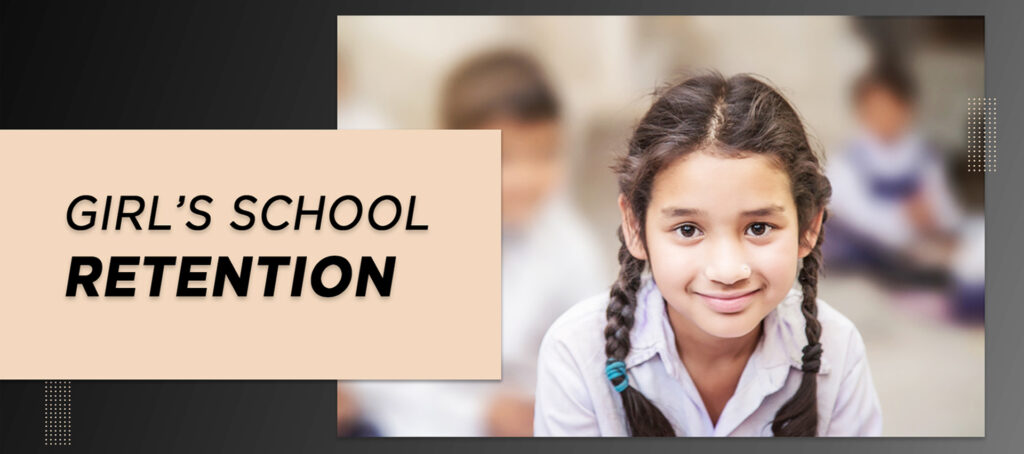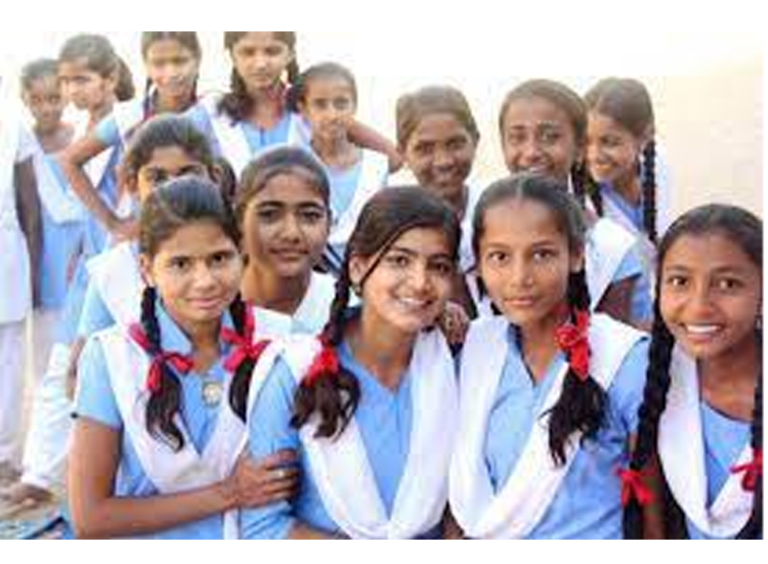
RETENTION OF GIRLS IN SCHOOL
In India, more girls (3.2%) are out of school than boys (2.7) even today in the cohort of children below 15 years of age. Adolescent girls and young women have been particularly vulnerable to the devastating consequences of COVID-19, and this is especially the case in India. In later adolescence, decisions are being made for girls about their futures, including their education and marriage.Looking at the current scenario, a policy brief issued by the Right to Education Forum in January 2021 shows that 10 million girls in India could drop out of secondary school due to COVID-19. Some recent studies also show that there existed a ‘gender-based digital divide’ in education that made the situation worse for female students.

5 actions to help bring the girls back to school after COVID-19:
- Lift financial barriers that prevent girls from going to school and that are likely to increase as a result of COVID-19 economic impacts.
- Scale gender-responsive distance education to reach the most marginalized girls.
- Intensify community mobilization and support for girls’ education, including for pregnant girls and those who were out of school before the COVID-19 crisis.Communities must monitor girls’ attendance once schools reopen, through school management committees and parent and teacher associations, and support their distance learning in the interim.
- Prioritize girls’ safety and protection.
- Ensure meaningful participation for adolescent girls.We should also recognize their creativity, innovative solutions, and effective partnership in shaping the response and recovery.
Underlying Causes:
- Poverty and Entrenched Patriarchy: Patriarchal social norms like child marriage, dowry, and restrictions on mobility of girls act as barriers in education of girls.
- Inadequate Budget: Education budget has seen persistent budget cuts over the years particularly from 2014 onwards. It is still at a staggering 3.4 % of the GDP. Even targeted schemes like the Beti Bachao Beti Padhao scheme aimed to raise awareness and improve welfare services for girls, spend nearly 60% of its budget on advertisements in 2018-19.23
- Access to Online Education Difficult Only 12.8 % women are able to use a computer, 14.9 % could use internet and interestingly only 12.5% women could access internet in the last 30 days. This is worse in rural areas. (7 %, 8.5% and 6.6%) (NSSO, 2017-2018). This has been found to be deepening inequalities in education during COVID-19 crisis.
- Governance and Financing for equitable and inclusive girls’ education: Governance in education should be responsive, accountable, transparent and ensure engagement of citizens.
ACTIVE ROLE OF CSR UNDER THIS ISSUE:
In 2021, CSR turns its attention to the long-term threats to women’s human rights and development. These health, economic, and welfare risks faced by young girls in gender critical districts include:
- Child Marriage/Early Marriage- a lack of economic insecurity pushing young girls into child marriage/early marriage by their families.
- Reduced investment in girls’ education families prioritizing boys over girls for educational prospects and opportunities.
- Low women’s workforce participation rate – women’s work-force participation rate declining for a decade in India reaching a low of 23.3% in 2020.
Because girls’ retention in school has a strong positive correlation with a delayed age of marriage, it is integral to support investment in girls’ education and eradicate the listed negative outcomes for young women. CSR’s proposed project focuses on strengthening structures to promote girls’ school enrollment and retention and access to skill training programs to enhance their agency.
The project will leverage the Community Watch Group (CWGs) and network infrastructure that were developed and strengthened during the 2018-2020 partnership with the Dutch Embassy on the ‘BetiBachao, BetiPadhao’program. CSR targets five gender-critical districts of Haryana for the advancement of girls through community and government support, as we are an established nodal agency of the Ministry of Women & Child Development, Government of India, with strong connections in community solidarity. The project will impact and support girls’ school enrolment and retention, which will advance community dialogue to delay child marriage and promote a secure and financially sustainable future for girls.
The following activities and methods will contribute towards the project“School Retention and Skill Training program for Adolescent girls of 3 Gender critical districts of Haryana”outcome in 3 gender critical districts of Haryana; Kurukshetra, Gurugram and Mahendergarh:
- A three-month needs assessment to determine specific needs of girlchildren of classes 8th-12th, from the impact of COVID-19.
- Mobilization of the community and parents in all five districts for theformation of CWGs and Parents Groups-Provision for 3 Field mobilizers.
- Rapport Building with School authorities and District level authorities.
- Mobilization/Establishment of Community Watch Group (CWG) andParents Groups in each district for generating awareness against childmarriage/early marriage, sex selection, and other threats to the girlchildren.
- Identification of parents of girl children who dropped out of school forspecific interventions.
- Enrollment of 100 girls per district (total 300) from Middle school tosenior secondary school (8th to 12th).
- Identification of socio-economically disadvantaged girl children toProvide100 scholarships for admissions.
- Strengthening NGO network (NGO Chaupal) and creating new networkpartners for retaining girls in school.
- 45 days Office Assistant Skill Training Program with certification fromMEPSC, Skill India, identification of placement opportunities/agencies,is providing placement opportunities wherever possible.
- Stakeholder’s Interface Workshop-Final Consultation- Sharing of Best practices on “education and retention of girl children in schools” with district authorities and concerned stakeholders.
Thus,
- Project activities are designed to reduce school drop-out rates and mitigate risks of early marriage through the formation of Community Watch Groups and Parents’ Bodies.
- The needs assessment will identify COVID-19’s impact on girl childrenand their specific requirements for continued retention in school
- The enrollment will support the retention of 300 girls in middle- seniorsecondary schools (100-150 girls enrolled per district).
- Scholarships for admission of 100 girls in 3 districts, on a socio- economic needs-based assessment, will ensure retention for the most at- risk girls
- District authorities and other stakeholders including CMGGA, PRIs willbe equipped with best practices to support girls’ school retention though government engagement.
- CSR’s skill development trainings will provide skill enhancement and placement opportunities to graduates, in collaboration with the MEPSC, NSDC across varied sectors.
- Field motivators will provide added support in job placements, and awareness of education.
Recommendations:
- Gender should be a cross-cutting theme in all policy formulations and strategies on education including budgeting at all levels, local/ Panchayat, state and central level.
- Increase budget for education, with funding incentivizing closing of gender-based disparities and closing the gap in per girl costs across states by lifting the floor of expenditure.
- Ensure optimum investment in issues related to safety, gender sensitization of teachers and accelerated learning for girls to enable their return and complete their education.
- Undertake regular gender and social inclusion audits of schools to inform education planning, budgeting, and management of resources.
- Strengthen sensitization of education management personnel on issues of gender transformative education.
- Strengthen mechanisms for grievance redress to allow instances of violations of educational rights to be reported and acted upon.
- Enable formations of SMC federations at the district and state level for longer and proactive engagement for making girls’ education inclusive and equitable.
